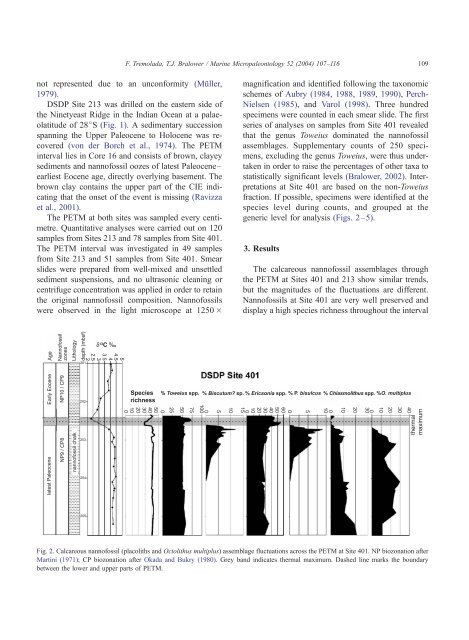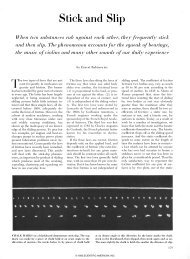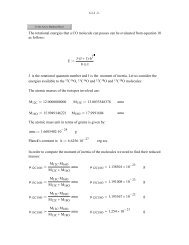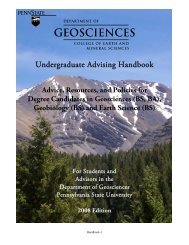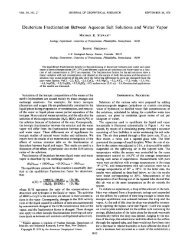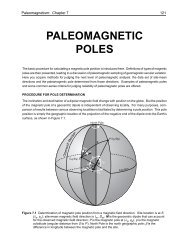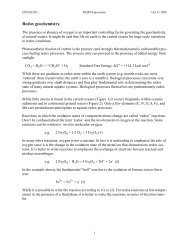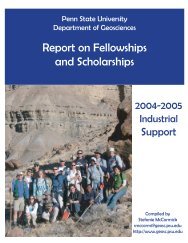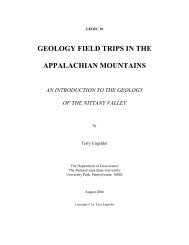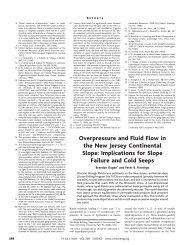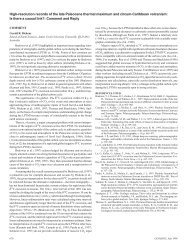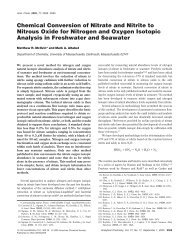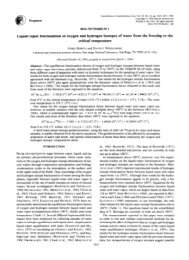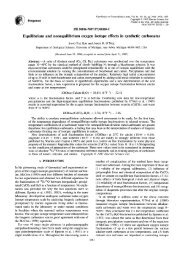Tremolada, F., and Bralower, T. J., 2004 - Penn State University
Tremolada, F., and Bralower, T. J., 2004 - Penn State University
Tremolada, F., and Bralower, T. J., 2004 - Penn State University
Create successful ePaper yourself
Turn your PDF publications into a flip-book with our unique Google optimized e-Paper software.
F. <strong>Tremolada</strong>, T.J. <strong>Bralower</strong> / Marine Micropaleontology 52 (<strong>2004</strong>) 107–116 109not represented due to an unconformity (Müller,1979).DSDP Site 213 was drilled on the eastern side ofthe Ninetyeast Ridge in the Indian Ocean at a palaeolatitudeof 28jS (Fig. 1). A sedimentary successionspanning the Upper Paleocene to Holocene was recovered(von der Borch et al., 1974). The PETMinterval lies in Core 16 <strong>and</strong> consists of brown, clayeysediments <strong>and</strong> nannofossil oozes of latest Paleocene–earliest Eocene age, directly overlying basement. Thebrown clay contains the upper part of the CIE indicatingthat the onset of the event is missing (Ravizzaet al., 2001).The PETM at both sites was sampled every centimetre.Quantitative analyses were carried out on 120samples from Sites 213 <strong>and</strong> 78 samples from Site 401.The PETM interval was investigated in 49 samplesfrom Site 213 <strong>and</strong> 51 samples from Site 401. Smearslides were prepared from well-mixed <strong>and</strong> unsettledsediment suspensions, <strong>and</strong> no ultrasonic cleaning orcentrifuge concentration was applied in order to retainthe original nannofossil composition. Nannofossilswere observed in the light microscope at 1250 magnification <strong>and</strong> identified following the taxonomicschemes of Aubry (1984, 1988, 1989, 1990), Perch-Nielsen (1985), <strong>and</strong> Varol (1998). Three hundredspecimens were counted in each smear slide. The firstseries of analyses on samples from Site 401 revealedthat the genus Toweius dominated the nannofossilassemblages. Supplementary counts of 250 specimens,excluding the genus Toweius, were thus undertakenin order to raise the percentages of other taxa tostatistically significant levels (<strong>Bralower</strong>, 2002). Interpretationsat Site 401 are based on the non-Toweiusfraction. If possible, specimens were identified at thespecies level during counts, <strong>and</strong> grouped at thegeneric level for analysis (Figs. 2–5).3. ResultsThe calcareous nannofossil assemblages throughthe PETM at Sites 401 <strong>and</strong> 213 show similar trends,but the magnitudes of the fluctuations are different.Nannofossils at Site 401 are very well preserved <strong>and</strong>display a high species richness throughout the intervalFig. 2. Calcareous nannofossil (placoliths <strong>and</strong> Octolithus multiplus) assemblage fluctuations across the PETM at Site 401. NP biozonation afterMartini (1971); CP biozonation after Okada <strong>and</strong> Bukry (1980). Grey b<strong>and</strong> indicates thermal maximum. Dashed line marks the boundarybetween the lower <strong>and</strong> upper parts of PETM.


